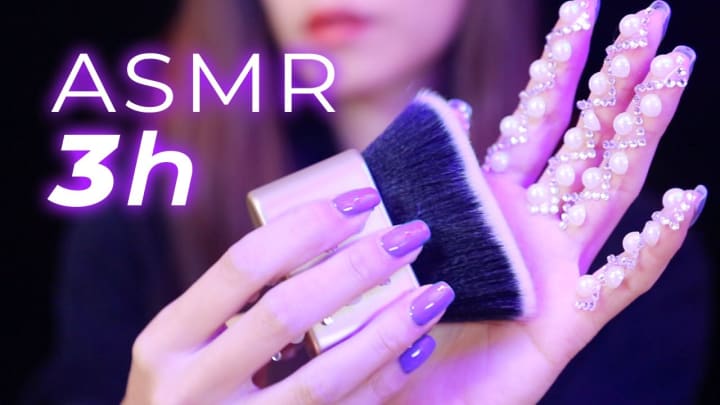Why is ASMR Now Days Growing Like A Fire?
The Reason Behind ASMR Senasatation.

Whenever Jennifer Allen watched recordings of the room, she now and again felt this particular sensation: shivering that spread through her scalp as the camera pulled back to show the marble of the earth. It arrived in a wave, similar to a warm foam, advancing down the length of her spine and abandoning a feeling of appreciation and completeness. Allen adored this inclination, however she didn't have any idea what caused it. It was absolutely unmistakable from anything she'd encountered previously. Like clockwork or so she'd take to Google. She had a go at looking through things like "shivering head and spine" or "mind climax." For nine years, the hunt didn't turn up anything.
Then, around 2009, it did. As usual, Allen composed her expressions into Google, yet this time she obtained an outcome on a message load up called SteadyHealth. The post was named WEIRD SENSATION FEELS GOOD:
I get this sensation some of the time. theres no genuine trigger for it. it simply happens haphazardly. its been occurring since I was a child and i'm 21 at this point. a few instances of what it appears has made it occur before are as a youngster while watching a manikin show and when I was being perused a story to. as a teen when a colleague helped me out and when a companion drew on the center of my hand with markers. here and there it occurs for not a great explanation by any means
The banner proceeded to request a clarification. In the conversation, no one had one, however many portrayed a comparative inclination - a "brilliant shimmer" inside the head, an euphoric "cerebrum gasm" or an inclination like goose pimples in the scalp that blurred "done in rushes of increased power." Many individuals concurred that the sensation was euphoric. ("Beside a real climax, it's likely the absolute most agreeable sensation," one client composed.) Its triggers were basically as shifted as watching somebody finish up a structure, standing by listening to murmuring sounds or seeing Bob Ross paint scenes on TV.
Allen looked at endlessly pages of conversation.
Goodness my gosh, she thought. These individuals are discussing the exact thing I experience.
On schedule, that post generated a subsequent post: WEIRD SENSATION FEELS GOOD - PART 2. As talk on the anonymous inclination advanced, clients shared inadvertent triggers saw as on the web - a man opening a harmed lock, somebody brushing her hair. These recordings shared a delicacy practically speaking that a large number of the clients viewed as difficult to depict. Some discussed the requirement for an examination gathering to more readily get the sensation. Still others communicated dread over friendly repercussions: Were they distorts? Is it true or not that they were debilitated? Might it be said that they were indigo youngsters? Joy is seldom outcome free.
"Individuals had been informed they were on medications or that they had lice - that's what things like," Allen says. "And afterward there was the variable of individuals calling it a 'cerebrum climax' and it seeming as though some kind of suggestive fixation sort of thing."
Allen had put a ton in the conversation, in any event, communicating interest in the youngster research exertion. She perceived how the inclination had worked on her feeling of quiet, yet she stressed that the subtext of a "shivering sensation" would keep the gathering away from authenticity. The entire thing sounded excessively cheesy - or excessively horny. If they had any desire to create logical interest, they required a more logical sounding name.
Thus in February 2010, she plunked down to conceptualize a few thoughts. Others had attempted to depict the peculiar sensation, however spacey monikers like "consideration instigated head climax" had never fully gotten on. Allen felt an obligation to the inclination's New Age fans, however she additionally saw the value of more clinical language. While no current term could meet the two circumstances, she made up another one: Autonomous Sensory Meridian Response, or A.S.M.R. She began with "independent" since it was an inclination from the inside; "tactile" was plain as day. "Meridian" worked triple obligation, recommending top yet in addition climax and the energy pathways of customary Chinese medication. "Reaction" was simply to say that it was anything but a consistent state; it occurred in response to a bunch of upgrades, such as murmuring, gum biting and tapping.
"I wish I'd made it somewhat more limited," Allen says. However, basically it sounded better than "cerebrum gasm."
She appeared the new name on the SteadyHealth board by reporting the "ASMR Group" she had enlisted on Facebook. Conversation board clients relocated as once huge mob, and soon participation spread over six mainlands: a blogger in South Africa, a craftsman in Detroit, an ethnobotany specialist working in Australia.
They began sharing connects to recordings once more - not the inadvertent triggers of before yet another kind made for the express motivation behind initiating A.S.M.R. These recordings frequently highlighted unknown ladies conveying mild-mannered voice-over portrayal. As per message-board legend, the first of this kind was a video named "Murmur 1 - hi!" It was posted in 2009 yet mulled in the algorithmic garbage dump of YouTube by virtue of its frail, unsearchable title. Presently, under the web search tool amicable flag of A.S.M.R., this new sort offered an on-request method for setting off the once-fortunate sensation. Another yield of YouTube makers arose to present the inclination to the individuals who realized they felt it - by then, a little yet developing subset of general society.
Around when Allen observed SteadyHealth, there were, by one count, 12 murmuring channels on YouTube; after three years, that number had dramatically multiplied. Before long a hard-won Wikipedia page would additionally expand the compass of the term - and further cherish the new video type. By 2015, the ASMR Group had made itself insignificant. Whenever Allen set off to name the unusual sensation, she thought she was essentially depicting what she felt. She was unable to predict that her term would empower a totally different type of amusement - or conceivably something that rose above diversion - brought into the world of the kismet of algorithmic destiny as it looked out for a way to improve against the crossed wires of the cerebrum.
Today the activity of A.S.M.R. plays out solely on YouTube, where armies of (for the most part female) makers discharge, according to my observation, around 500 new recordings every day. Throughout the span of revealing this article, I spent something like 200 hours on the site, watching ladies bite gum, swallow octopus sashimi, reproduce eye tests, switch pages of books and strip got stick dry fake ears. I watched an adolescent young lady pretend as a fourteenth century religious recluse, treating me for the bubonic plague. I watched a two-hour recording of hair-dryer sounds.

In the A.S.M.R. scene, recent fads advance rapidly, determined by the soul of development, corporate item arrangement bargains and a course of human-calculation connection that pushes the best new material to the top. Any trigger that begins to observe fans is perpetually taken up and reperformed - ripped off by various channels for promotion dollars - essentially until the following trigger takes its spot. One month, cranial nerve tests are in. The following month, makers are altogether shaving bars of cleanser, biting blocks of crude honeycomb or eating containers of KFC. The inclination that energizes this development is minimal perceived, similar to the dim energy pushing our universe outward.
The web is huge, however it unites like personalities. At its ideal, it joins unusual oddities, protesters of harsh systems and victims of dark sicknesses. Simultaneously, this inclination can serve the savage or deceived - giving shared language to Nazis and incels and other hopeless blockheads who were once kept kindly separated from each other. This component of the web is, best case scenario, esteem impartial; regardless, A.S.M.R. tests its cutoff points. The YouTube subculture is fortified not by conviction but instead by an unspeakable sensation - maybe whenever the web first has uncovered the presence of another inclination.
Masterminds since old Greece, while possibly not previously, have ended up fixated on the real essence of the faculties; even present day scholars get entangled talking about qualia, the unchangeable stuff of awareness. Subjectivity is difficult to segregate, by definition, and instances of new powerful sensations are not actually a normal event. Synesthesia, frequently experienced as partner numbers with colors, is one of the interesting models. However people since at minimum the nineteenth century have revealed tasting words, seeing sound or hearing tones, it took until the 1980s for researchers to demonstrate that the common experience really corresponded with genuine, recognizable movement in the mind.
Because of the web, A.S.M.R. appears to have jumped the science totally. Like synesthesia, it was first found via individual reports. Dissimilar to synesthesia, it has not relied upon mind imaging for social acknowledgment. Our principal "proof" of A.S.M.R. comes from certain individuals looking for the term and others making recordings to populate those ventures. This large number of YouTube clients might be correct that the inclination is genuine, yet the logical examination actually lingers a long ways behind.
Craig Richard, a teacher of physiology at Shenandoah University in Virginia, first heard the term in 2013, on a webcast. "I'm paying attention to the start of this episode thinking, 'This is a lot of charm bunk!' " he told me. Similarly as he went to turn the digital recording off, the subject changed to the painter Bob Ross - by then, at that point, a notable A.S.M.R. trigger. Richard's eyes illuminated. In adolescence, he spent evenings watching Ross paint scenes on TV. He thought often more about the painter than the canvas. "It was his disposition. It was the sounds he made and the manner in which he talked - the manner in which he examined the camera."
Whenever the episode was finished, Richard went to his PC to look into the exploration on A.S.M.R. By then, he saw as nothing scholarly - just sites and gatherings that drove him to the Facebook bunch. He contacted Allen, and as a team with an alumni understudy and individual from the local area named Karissa Burnett, they directed a casual web-based overview that, after some time, has gotten in excess of 25,000 intentional reactions. (Where do you feel shivers? Head, neck, arm? Do you feel loose? Do you feel stimulated?) Richard additionally began ASMR University, an internet based chronicle that today stays a helpful clearinghouse of exploration on the point.

All things considered, logical comprehension has moved gradually. Subsidizing for A.S.M.R. research is difficult to legitimize, and the assorted idea of A.S.M.R. triggers can prompt "loud" information. Until now, ASMR University records only 10 friend assessed papers. The greater part of these were distributed in creator pay diaries. The most thorough investigations use f.M.R.I. to plan the action of blood stream in the cerebrum as members report feeling the shivers. Results have recommended, in tiny examples, that A.S.M.R. could have something to do with socially holding "affiliative ways of behaving," known to deliver feel-great chemicals like oxytocin.
Richard, as far as it matters for him, thinks about these results from a transformative science viewpoint. He trusts that the shivers of A.S.M.R. are intended to aid proliferation and endurance, and calls attention to that triggers like prepping, murmuring and eye staring all look very similar to the manners in which that people relieve babies. In adulthood, a scope of comparable ways of behaving add to closeness between mates. This might be the situation, yet our ongoing seeing actually abandons a greater number of inquiries than addresses: If A.S.M.R. plays (or played) a key endurance job, for what reason does it appear to be that main certain individuals can feel it? For what reason would it be a good idea for it to become obvious just at this point?
It doesn't appear to be possible that the speed and extent of examination will at any point make up for lost time to the pattern of new satisfied. Until further notice, our main experts on A.S.M.R. are ladies and young ladies, alone at their PCs, controlling items for a nondescript, developing public.
Around the time that "Murmur 1 - hi!" was getting a move on in Allen's Facebook bunch, Gibi - today one of YouTube's top "A.S.M.R.tists" - was a sophomore in secondary school. (I've kept her last name here for underneath made sense of reasons.) Like numerous young people nowadays, she frequently experienced difficulty nodding off. Some of the time she would slip her telephone into her room and watch YouTube recordings to loosen up her brain. This propensity developed by a heedless cycle, drove by the impulses of a boundless sidebar. Cosmetics instructional exercises segued to knead, which before long gave way to A.S.M.R.
Since that game changing disclosure, Gibi has watched A.S.M.R. recordings each and every evening. The custom followed her off to school, where the recordings turned into a sort of repetitive sound she considered. A.S.M.R. was, by that point, not only for the individuals who encountered the shivers. The class had started to observe more extensive allure as a tranquilizer, an option in contrast to directed contemplation and a medication free, online form of Xanax.
The medium had fostered its own microstars, ladies with handles like Gentle Whispering ASMR and ASMRrequests, who shot themselves crinkling paper, tapping their nails on huge wooden dishes, managing cards, brushing hair and emptying cold milk into bowls of Cocoa Krispies. One of Gibi's top choices, Heather Feather ASMR, went past simple audio effects, performing full-scale pretend scenes imbued with mindful, intentional sound. In one, Heather regulated a visual impairment test, tapping her wand on a covered outline. In another, she played as a tattoo craftsman, taking a stab at a couple of purple nitrile gloves. Watching Heather's recordings caused Gibi to feel as though her "mind was swimming, positively." She played similar scenes over on rehash, getting back to parts that gave her the shivers.

By then, in June 2016, numerous A.S.M.R.tists dealt with YouTube like a side interest. Across channels, creation esteem shifted fiercely. A designer could post the ideal tapping video, then, at that point, vanish from the site for eternity. Gibi imagined that perhaps, with normal exertion, she could deliver a superior item - a quality channel with a standard timetable that tried out new, innovative triggers consistently. Thus, in the late spring before her senior year, she began her own channel, Gibi ASMR. a half year after graduation, she was acquiring enough in advertisement income to regard it as her regular work. Today she has around 1.8 million endorsers on YouTube.
About the Creator
Anshul Singh Tomar
I can define myself as a Design Thinker with a diversified portfolio of portals which includes Ecommerce Reviews, Job/Career, Recruitment, Real Estate, Education, Matrimony, Shopping, Travel, Email, Telecom, Finance and lots more.






Comments
There are no comments for this story
Be the first to respond and start the conversation.